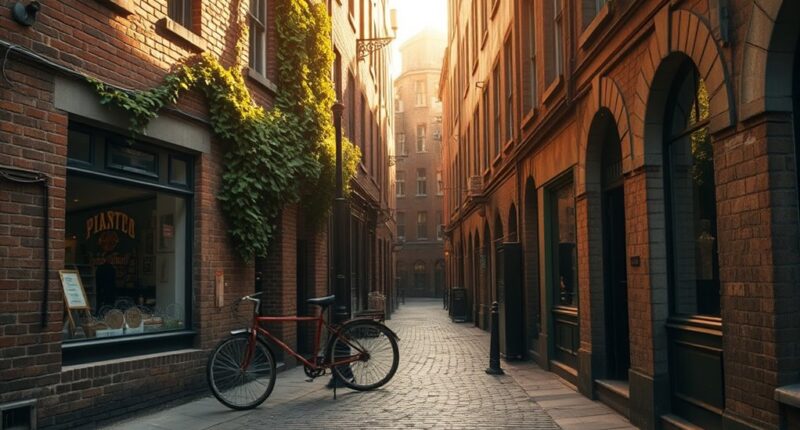To turn ordinary streets into iconic sets, focus on evaluating their visual impact and planning diverse shots that emphasize perspective and scale. Master lighting and shadows to create mood, using natural elements like trees or bustling activity for authenticity. Seek unique architectural details and authentic textures that add character. Consider natural lighting, cultural elements, and small details for depth. Proper permits and access planning ensure smooth filming. Keep exploring these secrets to transform everyday locations into cinematic gold.
Key Takeaways
- Assess visual impact and plan varied shots to enhance scene flexibility and depth.
- Use natural and artificial lighting creatively to set mood and add atmosphere.
- Identify unique architectural features and authentic details to give character and authenticity.
- Incorporate natural elements and cultural details to deepen realism and storytelling.
- Secure permits and access early to ensure legal, seamless filming and location utilization.
Assessing the Visual Impact of a Location
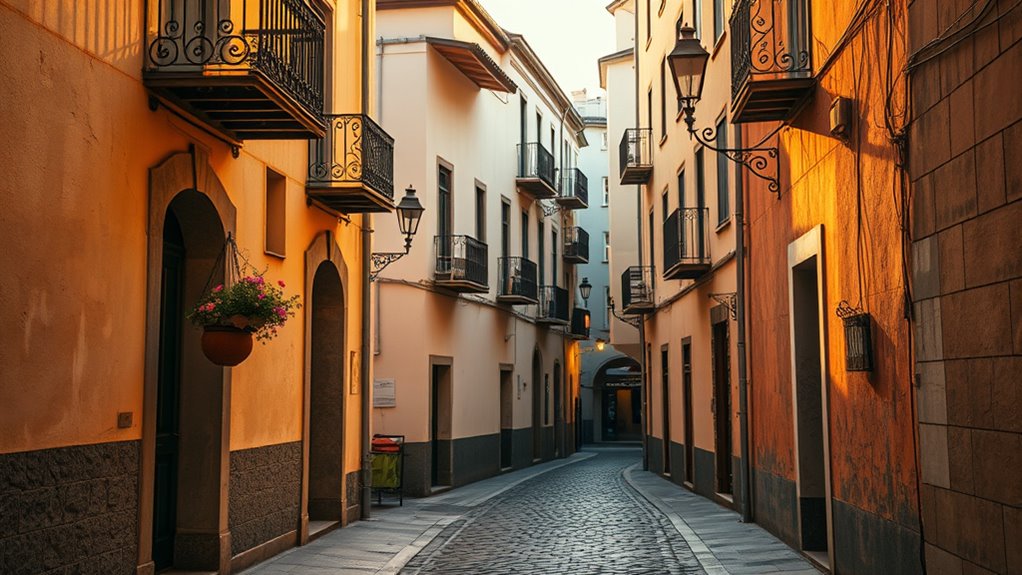
When evaluating the visual impact of a location, you need to assess how its scenery and features will appear on camera. Focus on scale and perspective, considering how objects relate to each other and to the viewer’s point of view. Large structures can dominate the frame, while smaller details may get lost if not framed correctly. Pay attention to spatial relationships—how elements are positioned in relation to one another—to create depth and visual interest. This helps determine whether the scene will feel expansive, intimate, or dynamic. By analyzing these factors early, you ensure the location complements your story’s mood and composition. Proper assessment of scale and perspective guarantees that your shots will be visually compelling and true to your creative vision. Additionally, understanding the contrast ratio of a location can influence how well the scene retains detail in both dark and bright areas, ensuring your footage maintains clarity and impact.
Mastering the Art of Light and Shadow
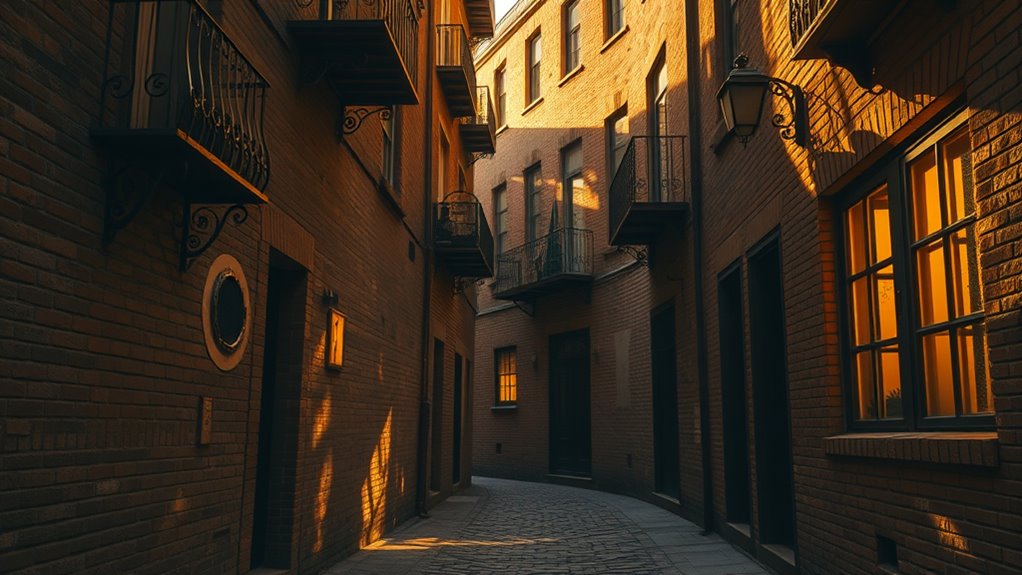
After evaluating a location’s visual impact, the next step is to harness light and shadow to shape your scene’s mood and focus. Shadow play can add depth and intrigue, emphasizing specific elements or creating mystery. Use light layering to build complexity, combining natural and artificial sources for dynamic visuals. Incorporating lighting techniques can further enhance the atmosphere and guide viewer perception.
Finding Unique Architectural Features
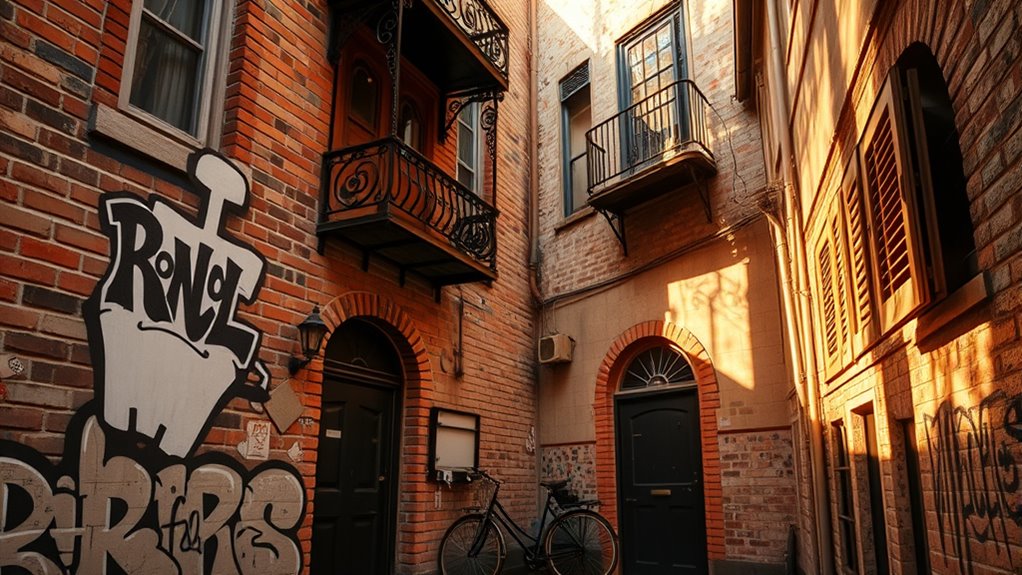
Look for distinctive details like intricate carvings or unusual shapes that make a building stand out. Explore structures with unexpected materials or finishes to add visual interest. By highlighting architectural contrasts, you can create striking images that tell a compelling story. Incorporating unique architectural features, such as vibrant facades or innovative design elements, can further enhance the visual appeal of your shoot.
Spot Distinctive Details
Have you ever noticed how some buildings stand out because of their unique architectural details? These small but impactful features can transform a simple street into a memorable location. Look for distinctive elements like intricate cornices, vintage urban signage, or colorful street art that add character and depth. Recognizing rustic decor elements can also help you identify locations that exude farmhouse charm and authenticity. These details help create a sense of place and authenticity on camera. Spotting them early allows you to leverage their visual interest, giving your shoot a rich, layered backdrop that elevates the scene.
Explore Unusual Materials
Unusual materials can give buildings a striking and memorable look that sets them apart from the ordinary. When scouting locations, look for structures made from unexpected materials like reclaimed wood, weathered metal, or textured concrete. These unusual materials add innovative textures that can transform a scene’s mood and atmosphere. For example, a brick wall with peeling paint or rusted metal panels creates visual interest and a sense of history. Don’t overlook surfaces that incorporate recycled or unconventional elements—they often carry a story and unique character. Using these materials, you can craft a distinctive setting that feels authentic and eye-catching. Exploring buildings with innovative textures driven by unusual materials broadens your options and helps you turn everyday streets into iconic, visually compelling sets. Resilience in design choices can also inspire creativity and adaptability in your location scouting process.
Highlight Architectural Contrasts
Architectural contrasts can instantly make a location stand out by blending or juxtaposing different styles and eras. This urban juxtaposition highlights the unique character of a site, emphasizing the clash or harmony between modern versus historic structures. To find these features, look for spots where sleek glass facades meet aged brickwork or where towering skyscrapers frame vintage buildings. Such contrasts can create a visually compelling backdrop for your shoot. Additionally, paying attention to preppy dog names can inspire stylish and sophisticated branding elements that complement the visual aesthetics of your location.
Utilizing Natural Elements for Atmosphere
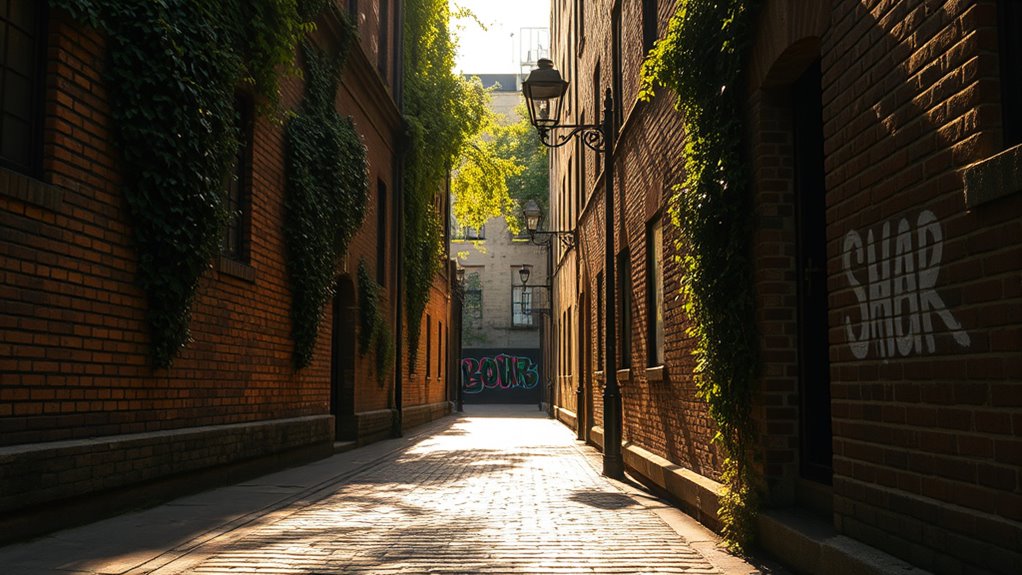
Natural elements can dramatically enhance the mood of your scene if you choose them wisely. Leveraging natural lighting creates authentic, dynamic visuals that set the tone without extra equipment. The time of day, weather, and shadows all influence the atmosphere, so scout for spots with ideal sunlight or diffused light. Ambient sounds also add depth; the hum of city life, rustling leaves, or distant sirens can immerse viewers in the environment. Use these sounds to enrich your scene’s feeling without artificial enhancements. Incorporate natural elements intentionally—perhaps a park with towering trees for serenity or a bustling street corner for energy. Additionally, selecting the right self watering plant pots can help maintain greenery effortlessly, enhancing natural scenery in your shots. When you harness these natural features effectively, your scene gains authenticity and emotional impact, transforming an ordinary location into an evocative setting.
Understanding Permits and Access Restrictions
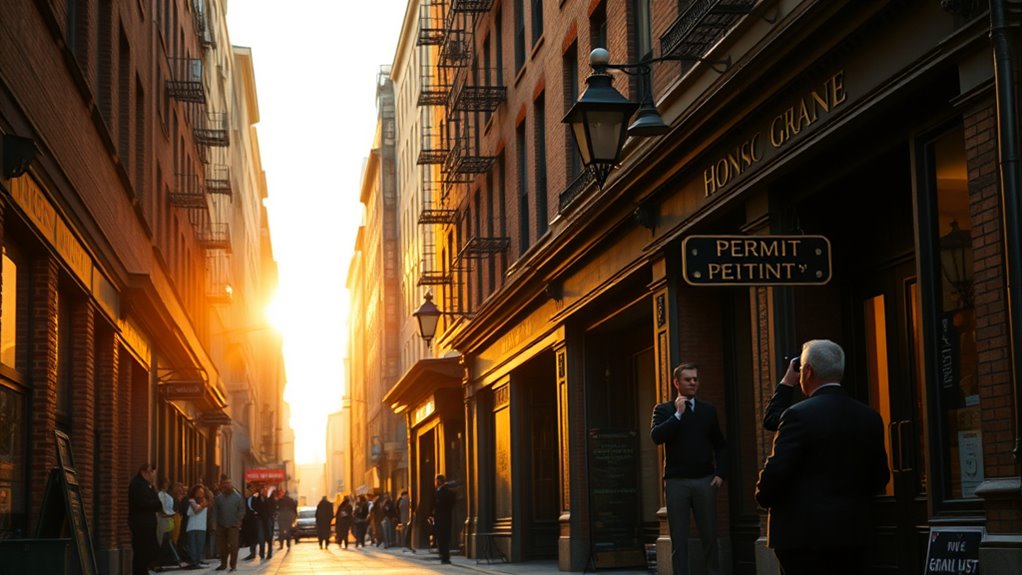
Understanding permits and access restrictions is vital to ensuring your filming runs smoothly and legally. Without proper permits, you risk delays, fines, or even shutdowns. Permit regulations vary by location, so researching ahead is essential. Access limitations might restrict your shooting times or the areas you can use, especially in busy or private properties. Being aware of ethical hacking principles can help you recognize potential security issues related to restricted areas or sensitive sites. Securing the necessary permits helps avoid legal issues and guarantees access stays open during your shoot. Knowing the permit regulations and access limitations allows you to plan effectively, making your location scouting seamless and stress-free.
Creating a Mood With Color and Texture

Have you ever thought about how color and texture can instantly set the tone of a scene? Understanding color psychology helps you choose hues that evoke specific emotions—warm reds for energy, cool blues for calm. Texture layering adds depth, creating visual interest and tactile richness. To illustrate, consider this table:
| Color Effect | Texture Layering | Mood Created |
|---|---|---|
| Red – Passion | Rough brick + smooth metal | Intensity, urgency |
| Blue – Calm | Soft fabrics + hard surfaces | Serenity, stability |
| Yellow – Optimism | Grainy concrete + glossy paint | Happiness, hope |
| Green – Growth | Natural wood + lush foliage | Renewal, freshness |
Using exfoliation techniques like glycolic acid can help in creating a clearer, more refined visual texture in scenes, making them more vibrant and engaging. Use these tools to craft a vivid atmosphere that transforms ordinary streets into iconic sets.
Incorporating Local Culture and Details
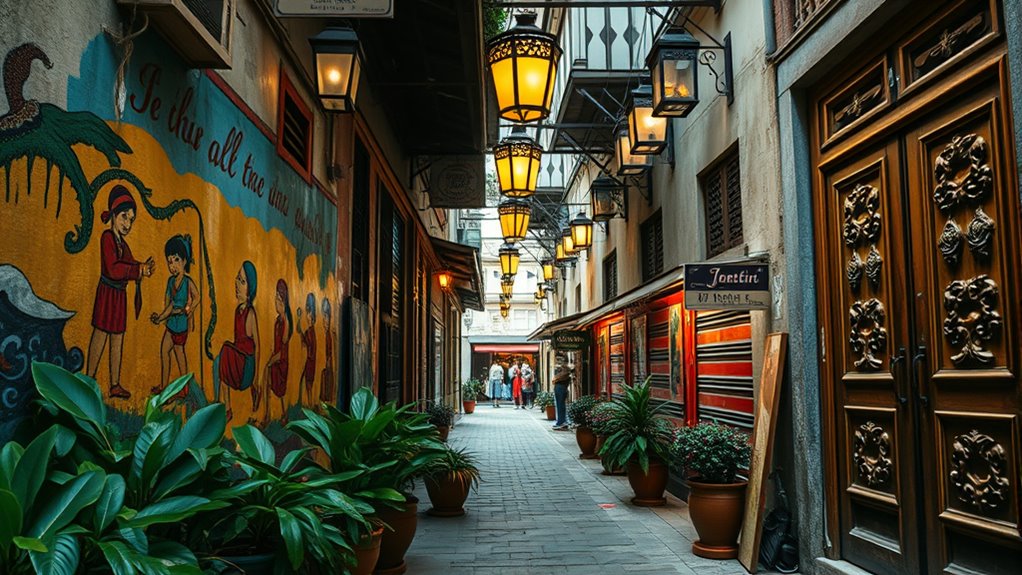
Incorporating local culture and details can instantly add authenticity and depth to your scenes, making them more engaging and believable. By highlighting local traditions and regional crafts, you create a setting that feels genuine and immersive. To do this effectively, look for ways to showcase cultural elements naturally within your shot.
- Use traditional architecture or signage to reflect regional identity
- Include handcrafted textiles or artisanal goods as props or backgrounds
- Capture local festivals, markets, or street performances to showcase vibrant traditions
These details enrich your scene, helping viewers connect with the location on a deeper level. Authentic touches like these make your set stand out and elevate the storytelling.
Planning Shots With Versatility in Mind

When planning shots, thinking ahead about versatility guarantees your scenes can adapt to different storytelling needs and editing choices. Focus on varied camera angles to capture multiple perspectives, giving you flexibility in post-production. Consider shot composition carefully—frame scenes to work well from wide establishing shots to close-ups. This approach allows for easier scene transitions and creative editing options. Additionally, paying attention to shot variety ensures your footage can be repurposed for multiple narratives or stylistic changes. Keep in mind that a well-thought-out shot list helps you visualize how each scene can be reconfigured. By designing shots with potential edits in mind, you ensure your footage remains adaptable. Versatility in camera angles and shot composition empowers you to craft dynamic scenes that fit multiple contexts, saving time and resources during filming and editing.
Enhancing Authenticity Through Small Details

You can make a location feel truly authentic by paying attention to small details. Weathered textures add depth, vintage props tell stories, and tiny touches help build the atmosphere you want. These elements work together to create a genuine, immersive setting that resonates with your audience.
Weathered Textures Add Depth
Weathered textures bring a sense of authenticity and character to your location shots by adding subtle, yet impactful, details. These textures reveal stories of urban decay, making scenes feel more real and lived-in. Incorporating weathered surfaces like peeling paint, rusted metal, or cracked concrete enhances the visual depth and mood. When you spot areas with natural aging, you create a richer environment that resonates with viewers. Small details like chipped bricks or faded signage can transform an ordinary street into an iconic setting. By focusing on these textures, you emphasize the history and grit that define the location’s personality.
- Capture the layers of paint peeling from walls
- Highlight rust on iron fixtures
- Focus on cracked pavement and worn surfaces
Vintage Props Tell Stories
Vintage props serve as tangible links to a location’s past, adding layers of authenticity that weathered textures alone can’t achieve. They become storytelling elements that immerse your audience in a specific era or mood, making scenes feel more genuine. When you incorporate vintage props—like old cameras, retro signage, or antique furniture—you create a visual narrative that hints at history and character. These small details can evoke nostalgia or suggest backstories without a word spoken. By thoughtfully selecting vintage props, you craft a richer, more believable environment. They transform an ordinary street into a place filled with history and personality, giving your set depth and context. Ultimately, vintage props are subtle yet powerful tools for storytelling that elevate your location’s authenticity.
Small Details Build Atmosphere
Small details can dramatically enhance the authenticity of a location by subtly shaping its atmosphere. When you incorporate elements like urban decay or bustling markets, you create a lived-in, believable setting. These small touches make scenes feel genuine and immersive. For example, weathered signs or peeling paint hint at urban decay, adding depth and history. Similarly, bustling market stalls with mismatched produce and worn crates evoke a vibrant, active environment. Pay attention to:
- Cracked pavements and graffiti to suggest neglect or history
- Cluttered stalls and varied merchandise for lively markets
- Weathered furniture or signage to reinforce urban decay
These details help transform an ordinary street into an iconic set, immersing your audience in a richly authentic world.
Frequently Asked Questions
How Can I Identify Hidden Gems in a City for Filming?
To identify hidden gems in a city for filming, start exploring neighborhoods beyond popular spots. Look for areas with unique neighborhood charm and architectural quirks that make each location stand out. Talk to locals for insider tips and walk around at different times to notice subtle details. Use online resources and maps to spot overlooked streets. Keep an open mind, and you’ll discover authentic spaces ready to transform into iconic sets.
What Are Cost-Effective Ways to Scout Locations?
Think of scouting locations as mining for gold—you want to strike rich without digging too deep. To do this cost-effectively, do a thorough cost analysis beforehand to avoid surprises. Use your smartphone for essential equipment, like a camera and a portable tripod, instead of costly gear. Visit locations during different times of day for better lighting and vibe, saving money on extras. This approach keeps your scouting both budget-friendly and efficient.
How Do Weather Conditions Affect Location Choices?
Weather conditions considerably impact your location choices. You should incorporate weather planning into your scouting process, considering seasonal considerations to avoid unexpected challenges. For example, avoid outdoor shoots during heavy rain or extreme heat, which can delay your shoot or damage equipment. Monitoring weather forecasts allows you to adapt your plans, ensuring you select locations that remain suitable and safe regardless of changing conditions, ultimately saving time and resources.
What Safety Precautions Should I Consider During Scouting?
Think of safety during scouting as your guiding star. You should always prioritize hazard awareness by inspecting the area thoroughly for potential dangers. Follow health protocols diligently, including wearing protective gear and staying hydrated. Keep a first aid kit handy, and scout with a partner when possible. Trust your instincts—if something feels off, it’s better to be cautious than sorry. Your safety is the foundation of a successful shoot.
How Can I Build Good Relationships With Local Authorities?
To build good relationships with local authorities, focus on community engagement by actively participating in local events and respecting community concerns. Be transparent about your plans and communicate openly to foster trust. During permit negotiations, show professionalism and flexibility, demonstrating that you value their input. Maintaining ongoing dialogue and showing appreciation for their support helps create a positive working relationship, ensuring smoother approval processes and collaborative success.
Conclusion
By applying these secrets, you transform ordinary streets into mesmerizing sets that tell a story. Will you seize the chance to see a location’s hidden potential and craft unforgettable visuals? Remember, every detail counts—light, texture, culture—all working together to create authenticity and impact. With keen observation and creative vision, the mundane becomes extraordinary. Are you ready to turn everyday streets into iconic scenes that leave a lasting impression?
